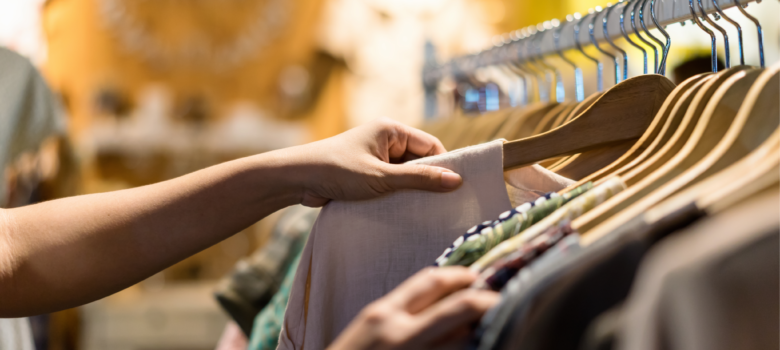
The production of fashion accounts for 10% of the worlds carbon emissions. Clothing is a big part of our daily lives, however in retrospect it is an even bigger part of the climate emergency happening right now.
For you to make an individual change might not seem like it will have much of an effect, but by doing your bit, you will help achieve a positive result for the environment. Join us in this blog looking at some of the ways we can make that positive impact!
Buy less clothes to save the planet
I know it may sound obvious, think carefully before you buy something. Have you ever bought something, never worn it, and after a few years of it hanging alone in your wardrobe you decided to get rid of it? Well, this is a major problem contributing to the environmental impact of clothing. Each year, 85% of textiles goes to the dump. Nearly all of these textiles are in perfect condition, or salvageable, which makes them almost pointless to throw away for the climate’s sake.
Next time you go shopping, make sure you are not going to regret buying anything, and if you do, make use of the shops return policy!
Sustainable brands are the way forward
Did you know, some clothing can be made from recycled plastics? Yes, it can! Some high street brands are using their platform for good and selling sustainable clothing. High street brands such as H&M, Urban Outfitters and ASOS are all participating in this, and you can easily find their sustainable sections on their websites.
Sustainable clothing also lasts longer in most cases, with eco- friendly fabrics being softer and stronger, sustainable clothing can guarantee you won’t have to keep buying new clothes.
Buy better quality clothing to save the planet
You get what you pay for – cheap clothing will fray, tear and get old quicker than good quality clothing. More durable clothing will mean that you won’t need to replace your clothes as often. Most of the time good quality, durable clothing is expensive, however you need to be thinking of long-term benefits.
Also, better quality can also be sourced locally. If you live it the UK or the United States, there are many local brands you can choose from. Avoiding buying clothes from halfway around the world will save a lot of potential carbon required to transport them into the countries that sell them.
Learn to sew to help the planet
Get that sewing kit out! So many clothes can be repaired with a simple stitch, and other textiles can be used for different purposes (in my house we use old t-shirts to get marks off the car with!). The thing is, sewing is such a cool skill to pick-up. How many of your friends can boast about knowing a great craft like this.
Also, linking back to buying less, if you regret purchasing a certain garment because it doesn’t fit properly, then have a go at making it fit. Give yourself a bit of a challenge! You can take dresses, trousers, shorts, etc up just by cutting them to the desired length and hemming – good as new!
Another option, if you aren’t so good with sewing, is to donate the clothes. You can take them down the local charity shop, or sometimes schools and local community organisations will offer to donate your clothes to people who need them. Anywhere is better than throwing them away.
Second-hand shopping
Fast fashion is a term used to describe the latest trends, produced at a low cost by mass market retail organisations. It is affecting the environment at a rapid pace, due to the majority of its products being thrown away by the consumer. The production of fast fashion uses masses of energy, water and increases the emissions of greenhouse gases significantly. Therefore, fast fashion is damaging the environment. ‘Slow fashion’ might be the future, but how can we stray away from investing in fast fashion when we see in display every time, we walk down the high street?
Well, in an aim to combat fast fashion, many shoppers are sacrificing the luxury of brand-new clothing and turning to second-hand shopping as an alternative. Essentially boycotting fast fashion organisations, and with a little help from Covid 19 shutting the shops (an unintended consequence), we have seen a major increase in the second-hand retail industry.
Second-hand shopping is becoming quite popular with the ongoing improvement of technology. Apps and websites such as eBay and Depop are allowing you to converse with people all around the world about old clothes.
From a personal experience, I use the Depop app almost every day to browse clothes and accessories. The app tailors its features to your own preferences, and some users agree to swap clothes if they like what each other are selling. This makes second-hand shopping very easy and almost like you are browsing in a real-life shop!
Additionally, there are many clothes that you only wear for a certain amount of time, like pregnancy clothing. These clothes can be sold, bought or swapped within second-hand shops and websites, instead of being thrown away, or buying brand new.
Of course, there are always charity shops, and busy places such as London offer various places to go ‘thrifting’. However, the online second-hand world offers much more in terms of ease and efficiency.
The environmental impact of laundry
One last thing to consider when being eco-friendly with clothing is how you do your laundry. When you wash your clothes, the average washing machine uses 19 gallons of water per load. So, you need to make sure the water is not wasted!
Here are a few ways you can make sure your laundry routine is eco-friendly –
- Make sure you are washing full loads and not just a few socks. By organising your washing for a few more minutes, you could turn two loads into one. This means you will be using half the amount of water, therefore helping the environment and saving on your water bills!
- Invest in an energy efficient washing machine. These are designed to reduce the amount of energy and water they use when washing laundry. Up to 80% of water can be saved, and they can result in up to 65% energy savings. Also compared to standard washing machines, they have the benefit of being able to wash more laundry in one go.
- Try not to wash your clothes after one wear – over-washing clothes can result in them degrading quicker, and if the wash isn’t needed, then nor is the water.
- Use green detergents – you can buy environmentally friendly detergents, which consist of no harmful ingredients. In most normal detergents, the harmful ingredients (synthetics, silicones, etc) get washed down the drain and eventually into the ground or the sea.
- Wash with cold water. Heating water uses much more energy, and you’ll find that some of your clothes require washing at lower temperatures, in order for them to stay in good condition.
- Take advantage of the sunny days, and don’t use a tumble dryer. I know it is hard to refrain from using the machine that does the job for you, but taking the time to hang the washing on the line, or using airer’s in the colder times will save you so much on your energy bills, and will be another step in helping the environment.
- Avoid dry cleaning. Dry cleaning involves the use of very harmful chemicals, which are toxic for the environment. So, by avoiding the dry cleaners, you will be saving the environment instead of quite literally killing it.












Fascinating points about the environmental impact of our wardrobes! I especially appreciate the emphasis on buying less and washing consciously. It aligns perfectly with the “slow fashion” movement gaining traction around the world. Did you know https://writinguniverse.com/ recently featured a lot of writing examples on this topic? They also for me offer a lot of writing inspiration. Check them out for a dose of creative ideas! Together, let’s rewrite the narrative of fashion, one mindful outfit at a time.